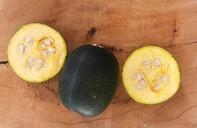Crop Rotation
It is normally good to follow a three to four year rotation cycle. Otherwise stringent soil fumigation and crop protection practices must be adhered to. The best practice is to consult the regional extension officer for advise on the best practice for rotation or risk mitigation.
Yield - Tonnes per Hectare
Conservative: 12 tonnes Average: 20 tonnes Good: 30 tonnesHarvesting
Harvesting is by hand. Use a sharp knife or shears to cut the stem of the gem squash fruit cleanly. Leave a 15 mm to 20 mm piece of the stem on the gem squash as this aids storage and stops diseases from entering the fruit.
Large producers use harvest platforms to more effectively remove the fruit from the land. Field packing is also done on these picking platforms.
Storage
Gem squash should not be stored for long periods as the yellow flesh starts to dry out. Storage should be in a cool and dry space and not for more than three weeks. Baby gems should be stored at cooler temperatures in a cool shed with slightly elevated relative humidity.
The fruit is still immature and should be eaten as soon as possible before the skin starts to harden. As Gem Squash can be cultivated most of the year somewhere in South Africa, because of the range of seasons, it is not really necessary to store. Just produce to a demand program.